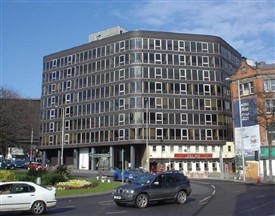Toll House Hill

Toll House Hill in 2012
Nottingham Street Tales
By Joseph Earp
Until about 1855 the lower portion of Derby Road was know as Toll House Hill.
The following item is from the '1648-9 Chamberlain's Account':
“Item, paid William Smalley for buildinge the Toll-house at Chappell Barre….. £02 00s 06d."
Although the above states Chapel Bar the building was on Toll House Hill, just outside the gateway (Bar).
Forty years on it is not in a very good state:
On Tuesday, September 16th 1690: “It is this [day] ordered, that whereas the Toll-house on the outside of the barr is falne downe, and the toll-house in the market-place out of repair, that the present Sheriffes shall build up the one, and repair the other, and be repaid by the Sheriffes, onely loseing 20s.; and so the Sheriffes successively loose Tenne shillings a peice, as it was customary, in payment of the Maces and staffes.”
Tolls were still collected, but not everyone was willing to pay.
In 1753 a William Birch of Sneinton refused to pay toll for "his Carrage loaded with goods comming into the Manor of Nottingham by the Chappel Bar."
The Toll House finally met its end on Friday, 30th December 1757:
“Ordered that Edward Spurr shall have Liberty to pull down the Toll House on the out side of the Chappell Barr and Sell the Materials for his own benifit he having paid five pounds to Mr. John Foxcroft Chaberlain as full price for the same for which sum Mr. Foxcroft to be accountable to this Corporation.”
After the demise of the Toll House on May 20th 1761:
“..to Joseph Newton, vitualler, and Joshua Fox, framework knitter, of a piece of waste ground outside Chappell Bar, near the side of Toll House Hill (on part of which the late lessee, Joseph Finch, erected a weighing machine, and on another part of which a new weighing machine has been since placed); for thirty-one years from 25 March last, at a yearly rent of 5s.”
In January 1772 it was agreed to repair and widen the road to Derby (Toll House Hill formed the Nottingham end of it).
In December of 1782 the “Publick Well”, outside Chappell Bar, had a pump fitted costing 12 guineas.
An original unnamed hill, that ran up and joined Back Lane (now Wollaton Street) was named on the “Staveley and Wood” map of 1831 as Toll Street and this still exists today (it ran parallel to Toll House Hill both converging on the Chapel Bar Gateway).
Article by the Nottingham Hidden History Team.